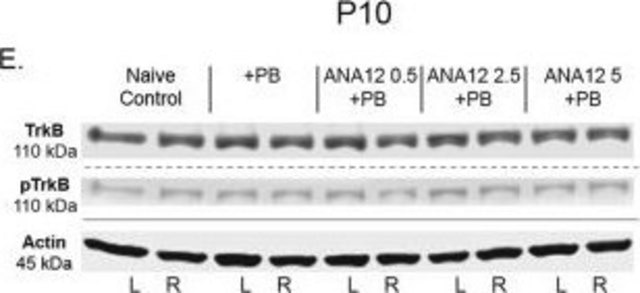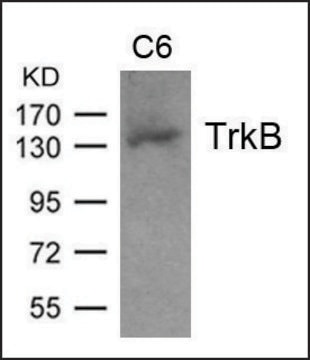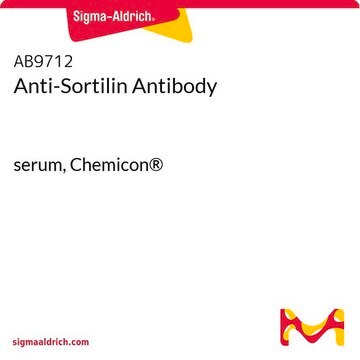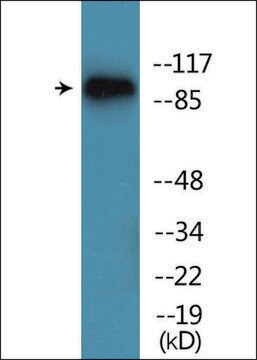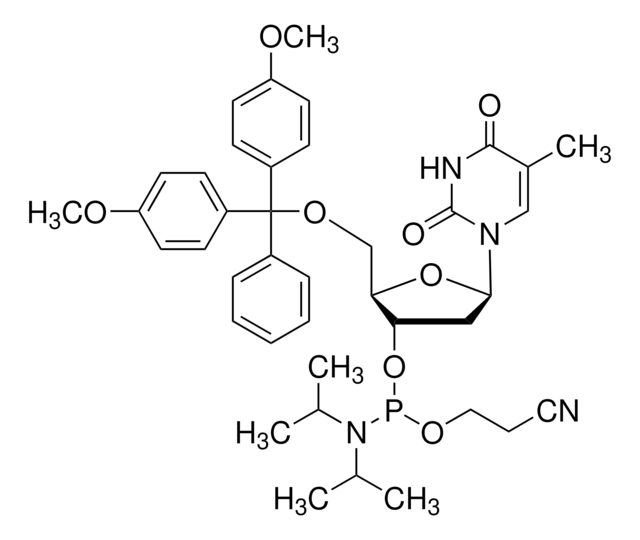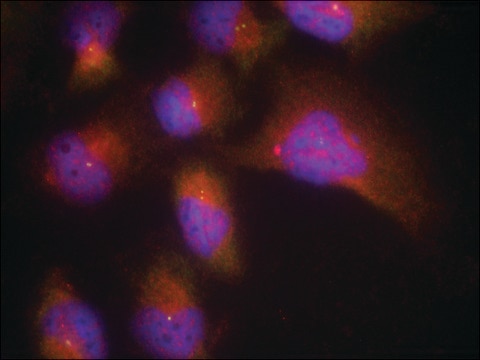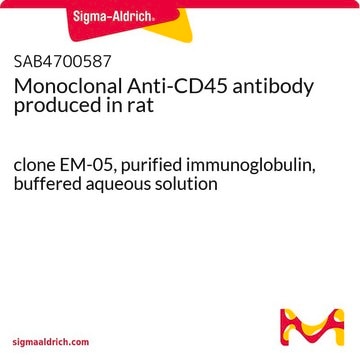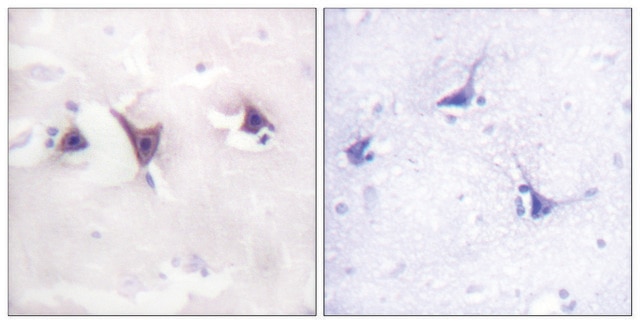AB9872
Anti-TrkB Antibody
serum, Chemicon®
Synonym(s):
Tyrosine kinase receptor B
Sign Into View Organizational & Contract Pricing
All Photos(1)
About This Item
UNSPSC Code:
12352203
eCl@ss:
32160702
NACRES:
NA.41
Recommended Products
biological source
rabbit
Quality Level
antibody form
serum
antibody product type
primary antibodies
clone
polyclonal
species reactivity
mouse, rat
manufacturer/tradename
Chemicon®
technique(s)
immunohistochemistry: suitable
NCBI accession no.
UniProt accession no.
shipped in
dry ice
target post-translational modification
unmodified
Gene Information
human ... NTRK2(4915)
Related Categories
General description
The mammalian Trk family of receptor tyrosine kinases consists of three principle transmembrane proteins. The receptors can be activated by one or more of four neurotrophins - NGF, BDNF, NT3 and NT4/5. The TrkB family of transmembrane proteins serves as receptors for BDNF and NT-4/5 and these neurotrophins regulate biological responses such as cell survivial, proliferation and differentiation in normal and neoplastic neuronal cells.
Specificity
Other species have not yet been tested. It is expected to react with a wide range of mammalian species, based on the high sequence similarity.
trkB [BDNF/NT-4/5 growth factor receptor; tyrosine kinase receptor B]. The immunogen sequence was chosen to avoid cross reactivity with trkA or trkC.
Immunogen
Extracellular domain of the recombinant mouse receptor expressed in mammalian cells.
Application
Anti-TrkB Antibody is an antibody against TrkB for use in IH.
Immunohistochemistry: 1:3,000. The antibody has been used successfully on rat dorsal root ganglion and trigeminal ganglia in the rat spinal cord (cryostat free-floating sections). Suggested fixative is 4% paraformaldehyde.
Not suitable for Western blot.
Optimal working dilutions must be determined by end user.
Not suitable for Western blot.
Optimal working dilutions must be determined by end user.
Research Category
Neuroscience
Neuroscience
Research Sub Category
Neurochemistry & Neurotrophins
Neurochemistry & Neurotrophins
Physical form
Lyophilized. Reconstitute with 50 μL of sterile distilled water. Centrifuge to remove any insoluble material. Contains no preservative.
Serum
Storage and Stability
Maintain lyophilized material frozen at -20°C to -70°C for up to 12 months after date of receipt. After reconstitution maintain at -20°C in undiluted aliquots for up to 6 months. Avoid repeated freeze/thaw cycles. Glycerol (1:1, ACS or better grade) can be added for additional stability.
Legal Information
CHEMICON is a registered trademark of Merck KGaA, Darmstadt, Germany
Disclaimer
Unless otherwise stated in our catalog or other company documentation accompanying the product(s), our products are intended for research use only and are not to be used for any other purpose, which includes but is not limited to, unauthorized commercial uses, in vitro diagnostic uses, ex vivo or in vivo therapeutic uses or any type of consumption or application to humans or animals.
Not finding the right product?
Try our Product Selector Tool.
wgk_germany
WGK 1
flash_point_f
Not applicable
flash_point_c
Not applicable
Certificates of Analysis (COA)
Search for Certificates of Analysis (COA) by entering the products Lot/Batch Number. Lot and Batch Numbers can be found on a product’s label following the words ‘Lot’ or ‘Batch’.
Already Own This Product?
Find documentation for the products that you have recently purchased in the Document Library.
Matthew D Johnson et al.
Tumour biology : the journal of the International Society for Oncodevelopmental Biology and Medicine, 39(2), 1010428317692256-1010428317692256 (2017-02-22)
This study investigated the Trk receptor family as a therapeutic target in pancreatic ductal adenocarcinoma and assessed their prognostic significance. Global gene expression analysis was investigated in prospectively collected pancreatic ductal adenocarcinomas that had either undergone neoadjuvant chemoradiation or were
Silvia Ginés et al.
The European journal of neuroscience, 23(3), 649-658 (2006-02-21)
Deficits of neurotrophic support caused by reduced levels of brain-derived neurotrophic factor (BDNF) have been implicated in the selective vulnerability of striatal neurones in Huntington's disease (HD). Therapeutic strategies based on BDNF administration have been proposed to slow or prevent
Methods for Evaluating Cell-Specific, Cell-Internalizing RNA Aptamers.
Hernandez, LI; Flenker, KS; Hernandez, FJ; Klingelhutz, AJ; McNamara, JO; Giangrande, PH
Pharmaceuticals (Basel, Switzerland) null
Rui P Galvão et al.
The Journal of neuroscience : the official journal of the Society for Neuroscience, 28(50), 13368-13383 (2008-12-17)
In rodents, the adult subventricular zone (SVZ) generates neuroblasts which migrate to the olfactory bulb (OB) and differentiate into interneurons. Recent work suggests that the neurotrophin Brain-Derived Neurotrophic Factor (BDNF) can enhance adult SVZ neurogenesis, but the mechanism by which
Our team of scientists has experience in all areas of research including Life Science, Material Science, Chemical Synthesis, Chromatography, Analytical and many others.
Contact Technical Service